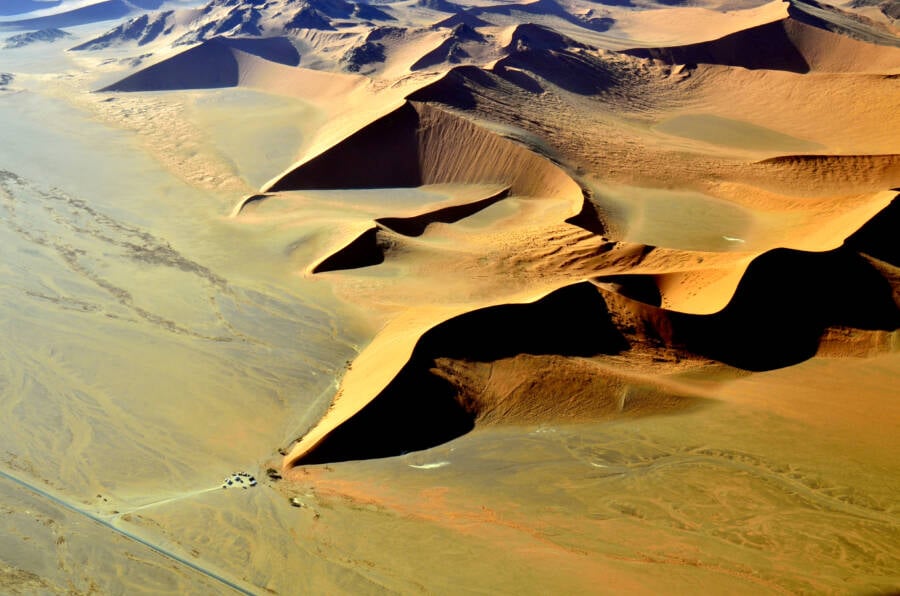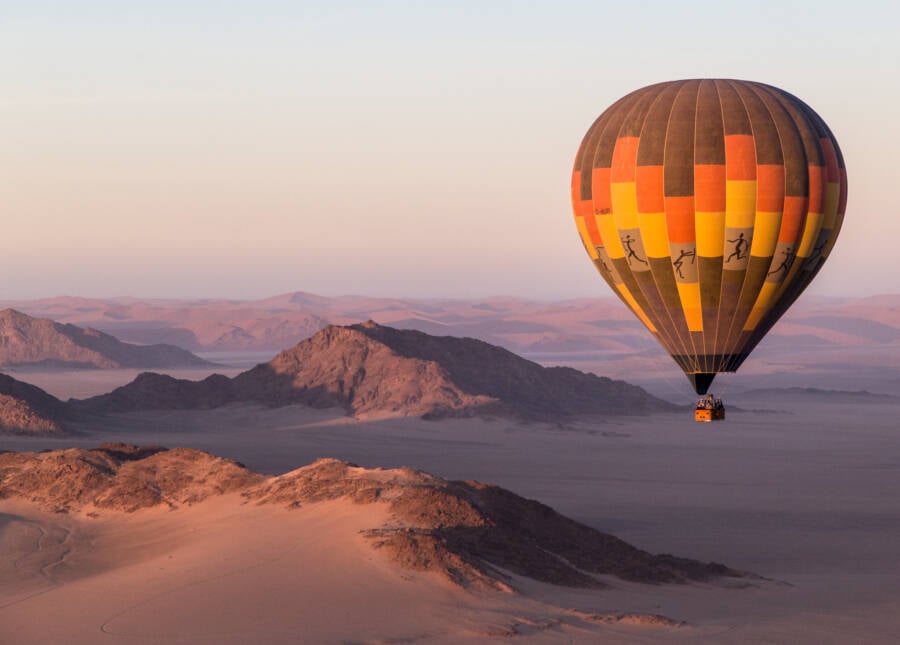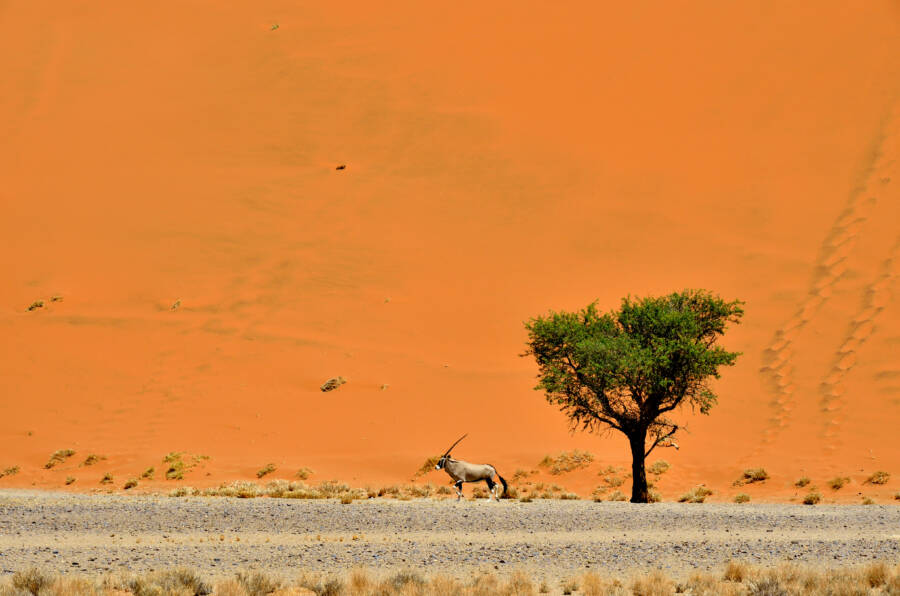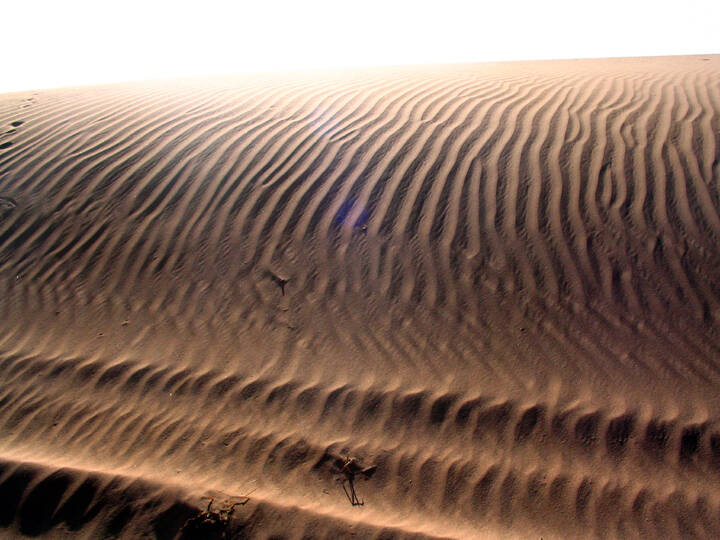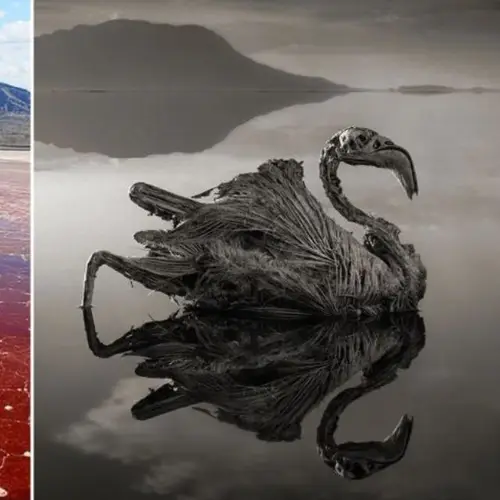The Sossusvlei is an ancient salt pan in Namibia's Namib Desert that transforms into an oasis once a decade.
Inside Namibia's Namib-Naukluft National Park sprawl massive dunes that glow orange, pink, and red under the burning sun. These magnificent hills are made of sand so old that it has literally rusted over its millions of years on Earth, and in between them lies an alien desert of white salt known as the Sossusvlei.
"Sossuvlei" — which translates to "Dead Marshes" from Afrikaans — is cupped by sand dunes that tower over 1,300 feet tall and are among the highest sandhills in the world. The Sossusvlei basin, along with its similar counterpart known as the Deadvlei, is among the most photographed areas of Sub-Saharan Africa.
The Sossuvlei Is Made Of Ancient Rust
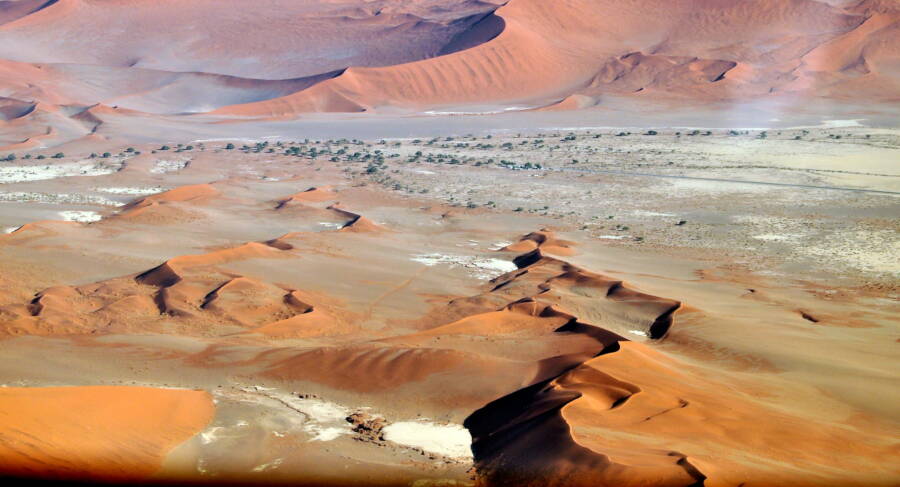
erix-pix/FlickrThe Namibian desert is a wonder of various geographic forms, including the salt flats of the Sossusvlei and the surrounding rusted sandhills.
The Sossusvlei is a natural wonder comprised of salt that contains a layer of clay in its subsoil. It remains a dry basin, except for once every five to ten years when it finds itself overflowing with water from the nearby Tsauchab River.
When filled with water, the clay subsoil in the Sossusvlei becomes sticky and plasticized like putty, giving the basin its nickname: the "point of no return."
Visitors from all over the world come to witness the sight when the Tsauchab fills the flat as glassy reflections from the resulting lake make for excellent photography. During this time, the cracked mud basin transforms into an oasis with a blue-green lake, sprouting foliage, and aquatic birdlife.
The basin can hold water for up to a full year before it is reabsorbed by the land. Small animals that can survive with very little moisture live near Sossusvlei including some arthropods, small reptiles, and rodents.
The more stable dunes in the salt basin are somewhat covered with vegetation year-round, as they are watered mainly by several underground rivers, and are thus able to sustain these little critters. The highest dune in the Sossusvlei area proper is called "Big Daddy," and it stands 1,066 feet tall. "Big Daddy" faces another massive dune that is known, of course, as "Big Mama."
The dystopic landscape has made appearances in many movies, and nearly every story or article written about the country of Namibia features a photo of it. In the film The Cell, the desert landscape represents a dream-like virtual reality. It's also featured in the movies The Fall and Steel Dawn.
In The Nearby Deadvlei, Not Even The Dead Can Disappear

djmccrady/FlickrIn the Deadvlei, the environment is so dry that not even the dead can decompose.
But there is another more treacherous "point of no return."
Nearby the Sossusvlei sprawls a second "dead marsh" known as the Deadvlei, which is even more desolate than its neighbor. Here, the dunes block any access that the Tsauchab River may have once originally had to the basin and is thus so dry and arid that even dead trees cannot decompose — they simply scorch black under the sun.
You may think this environment wouldn't be too friendly to flora or fauna. However, there are pockets of life even within the Deadvlei. The landscape is dotted with salsola shrubs, which are part of the saltbush family, and Acanthosicyos horridus, an unusual melon that is actually native to the Namib desert. These organisms manage to sustain themselves on occasional morning mists that blow in from the Atlantic Ocean.
The desert is also populated by the Oryx, a creature similar to an antelope. These creatures can conserve water and withstand extreme heat that would prove fatal to many other animals by cooling the blood that flows to its brain.
Africa's apex predator, the desert lions of Namibia, may also be found wandering the Sossusvlei basin, as well as another drought-adapted animal known as the rare desert-dwelling elephant.
The Namib Desert Is The Oldest On Earth
The Namib-Naukluft National Park, in which the desert resides, takes up around 8,880 square miles of land and protects areas of ecological importance. This park also shares a boundary with the NamibRand Nature Reserve; a private reserve protecting and conserving the ecology and wildlife of the region. It is one of the oldest reserves in Namibia.
The Namib Desert itself, meanwhile, has existed for around 55 million years.
The dystopic plane comes from the ethnic Nama word namib, which also inspired the country's name, which means "vast dry plain."
Then there are the Naukluft Mountains, the southern part of which form the easternmost part of the park. Characterized by high plateaus bounded by gorges, caves, and springs, the mountains themselves are a thing of beauty. The northern part of the Naukluft Mountains, meanwhile, consists of mainly private farms.
If you're looking to visit Sossusvlei, mountain passes provide excellent viewpoints. On the other hand, some of the passes are harder to travel, so you'll also need a vehicle equipped to drive through sand.
Accommodations can be found inside the park, and you can book scenic flights over the dunes. Hot air balloon tours depart from the nearby settlement of Sesriem every morning.
It's a 44-mile trek from the Namib-Naukluft Park gates to Sossusvlei and Deadvlei, and a bucket-list worthy experience is witnessing the sunrise or sunset over the desert dunes. The skies here are said to be among the clearest you'll ever see.
Next, find out how a new African ocean reserve in Gabon will protect sea turtles, dolphins, and whales. Then, for those with an iron stomach, read about the brutal South African punishment known as necklacing, which was reserved for traitors to the anti-apartheid movement.

